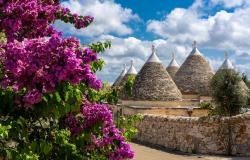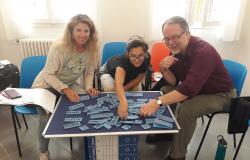Words by Carla Passino
Want to make authentic Italian dishes at home? Then run to get yourself a copy of La Cucina, the cookery book published by the Italian Academy of Cuisine.
Founded in 1953 by some of the most distinguished intellectuals of the time, including the writer Dino Buzzati, book publisher Arnoldo Mondadori and architect Gio Ponti, the Academy has made its mission to preserve Italian culinary traditions and fight what it calls forgeries - dishes that share the same name with original Italian recipes, but little else.
“The Academy is a one-of-a-kind institution, which has been acting for fifty years both in Italy and abroad to save the enormous cultural wealth represented by Italian food and gastronomic traditions, which are a symbol of national identity but also testament to the evolution of Italy’s new trends and habits,” the body explains in its mission statement.
Over the last few years, reports the Academy, the number of ‘forgeries’ has grown immensely. Worse, it is no longer a matter of foreign cooks misinterpreting an Italian recipe - in Italy too, many restaurants serve dishes that flout traditional ingredients and cooking methods. Risotto, pasta al pesto, tortellini, but also regional staples such as bagna caoda or cannoli alla siciliana are among the most frequently “betrayed” recipes.
“Eating a dish made using a ‘counterfeit’ recipe obviously will not harm your health but, unfortunately, it risks to hurt our national gastronomy,” says Academy President Giovanni Ballarini.
 The situation is so dire that “in 20 or 50 years we may no longer remember how to cook a pasta alla carbonara or a costoletta alla Milanese,” the Academy warns. To fight this perilous decline, the institution embarked on a painstaking research over the course of many years, surveying village after village, farmstead after farmstead, to collect some 2,000 classic Italian recipes, which it published on its website www.accademiaitalianacucina.it. Now, the recipes are available in English, presented in a hefty 928-page tome titled simply La Cucina.
The situation is so dire that “in 20 or 50 years we may no longer remember how to cook a pasta alla carbonara or a costoletta alla Milanese,” the Academy warns. To fight this perilous decline, the institution embarked on a painstaking research over the course of many years, surveying village after village, farmstead after farmstead, to collect some 2,000 classic Italian recipes, which it published on its website www.accademiaitalianacucina.it. Now, the recipes are available in English, presented in a hefty 928-page tome titled simply La Cucina.
The book covers virtually every Italian course and region, and provides rigorous descriptions of both ingredients and techniques for every dish. So for example, the recipe for costoletta alla Milanese tells you exactly how thick the meat should be (cut as high as the bone), how fine the breadcrumbs should be (coarse) and what you should do with the butter (warm it up, don’t fry it)—although readers outside the United States may object to the publisher’s choice to use American cooking measurements and terminology.
As you’d expect from an institution that sets out to protect Italy’s gastronomic heritage, the Academy makes no concessions for creative interpretation (or time-saving changes) in its book. However, it does make allowances for regional or even provincial variations - such as the Roman habit of using rigatoni rather than spaghetti in pasta alla carbonara - thus offering an insight into just how deeply, intricately local Italian culture really is. Indeed, it is localization that makes it a truly fascinating read. Even the most experienced of connoisseurs will find recipes they have never heard of, let alone tried. Acquasale for example is virtually unknown outside its home region of Basilicata, but it is an ingenious product of the local farmwives, who found a way to turn cheap, plain ingredients - tomatoes, parsley, chilli, even stale bread - into a delicious soup. The same applies to polpettine al baccala, rissoles made with stockfish, milk, bread and white wine, which comes from Le Marche. My favourite find, though, is fusilli alla Molisana, a hearty pasta with lamb, veal, sausage, lard, chilli and tomato sauce, that I’d recommend you to try right away.
And while you enjoy eating it, you will also have the satisfaction of doing your bit to preserve a crucial part of Italy’s heritage.
La Cucina is available for sale through amazon.co.uk and amazon.com.













